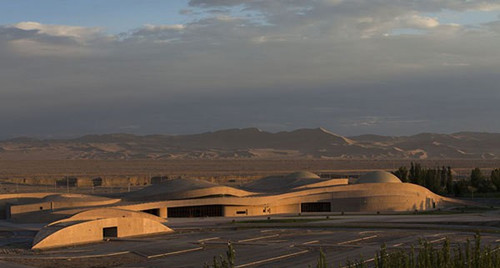
. > TOP STORIES
Experts divided over digitalization of cultural heritage
Author : Li Yongjie, Zhang Xinying Source : Chinese Social Sciences Today 2014-08-28
The Dunhuang Mogao Grottoes Visitor Center was inaugurated on August 1. The center, which screens high-definition digital movies and hosts simulated experiences, gives visitors the chance to reach out and try to “touch” flying Apsaras, or female spirits in Buddhist mythology. But the emergence of a “digital Dunhuang” has triggered concern over the role of technology in cultural heritage protection.

The Dunhuang Mogao Grottoes Visitor Center, which screens high-definition digital movies and hosts simulated experiences, seen from the outside. It opend to visitors on August 1.
Technology is widely used in cultural heritage presentation and protection. “Digital images allow people to feel Dunhuang closely. At the same time, it reduces damage to paintings caused by visitors,” said Wang Jiqing, a professor at Lanzhou University’s Institute of Dunhuang Studies. Wang added that digital displays are now “extensively used in museums, libraries, and painting and calligraphy circles.”
Li Fengliang, director of Shenzhen University’s Institute of Cultural Industries, noted that technology is playing an increasingly important role in intangible cultural heritage protection. “Due to highly diversified categories, intangible cultural heritage’s inheritance and protection are meeting many difficulties. Experts hope to expand the channel of their protection, transmission and inheritance through digital applications,” said Li.
Zhang Xiaoming, a research fellow at the Chinese Academy of Social Sciences’ Research Center for Cultural Policy, said that digital displays are now not only limited to government departments and units for heritage protection, with some social organizations and private enterprises also tapping the benefits of such technology.
Huang Chunyu, a history professor at Nankai University, argued that widely-used digital displays arouse people’s consciousness for preservation and inheritance of cultural heritage. “As the origins of some cultural heritage date back many centuries, sometimes people find it hard to appreciate their value. Rich in forms and vivid in presentation, digital displays can draw people’s attention and guide them to better understanding and protecting cultural heritage,” said Huang.
Cultural connotations are not to be overlooked in digital display. “The Internet and information technology are conducive to the in-depth exploitation and utilization of cultural heritage,” Li said.
But Huang expressed concern over excessive importance being attached to technology, pointing out that cultural heritage protection units should consolidate the preservation and exhibition of sites and artifacts rather than solely focusing on keeping pace with the development of new technologies.
Both Li and Huang agreed that while advocating greater use of technology, it is important to maintain the original cultural meaning of sites and relics.
Diao Changyu, an associate professor at Zhejiang University’s Institute of Cultural Heritage Studies, has been providing technological support for the digitalization of cultural heritage at Dunhuang. He stressed that technology is only a “tool and means” to protect cultural heritage. Digital experts must keep in mind the essential demands of cultural heritage protection, said Diao, and apply appropriate methods to solve problems.
Currently, there are many digital systems and databases at Chinese cultural heritage sites. Zhang urged a standardized criterion and national unified digital platform to ensure consistency. He also called for relevant laws and regulations to be passed and implemented to guide resource allocation and combat misuse of digital resources.
The Chinese version appeared in Chinese Social Sciences Today, No. 634, Aug 15, 2014.
The Chinese link: http://www.cssn.cn/zx/bwyc/201408/t20140817_1293961.shtml
Translated by Du Mei
Ye Shengtao made Chinese fairy tales from a wilderness
Ye Shengtao (1894–1988) created the first collection of fairy tales in the history of Chinese children’s literature...
-
How northern ethnicities integrated into Chinese nation
2023-09-18
-
Mogao caves
2023-09-12
-
Mogao Grottoes as ‘a place of pilgrimage’
2023-09-12
-
Time-honored architectural traditions in China
2023-08-29
-
Disentangling the civilizational evolution of China
2023-08-28
-
AI ethics in science fiction
2023-08-23













 2011-2013 by www.cssn.cn. All Rights Reserved
2011-2013 by www.cssn.cn. All Rights Reserved